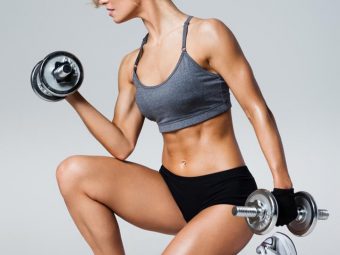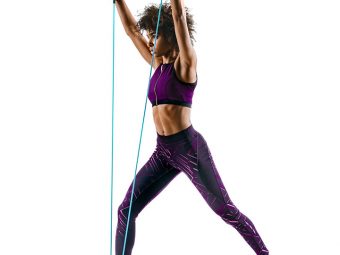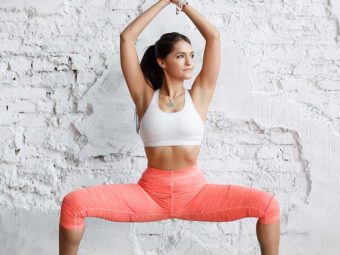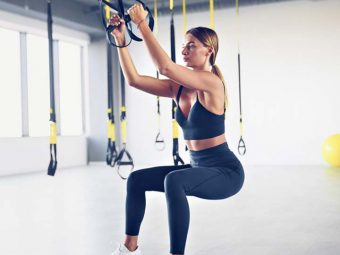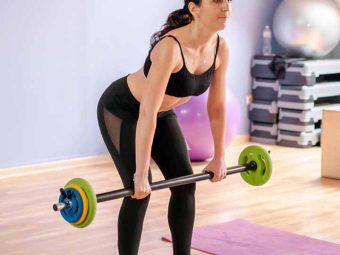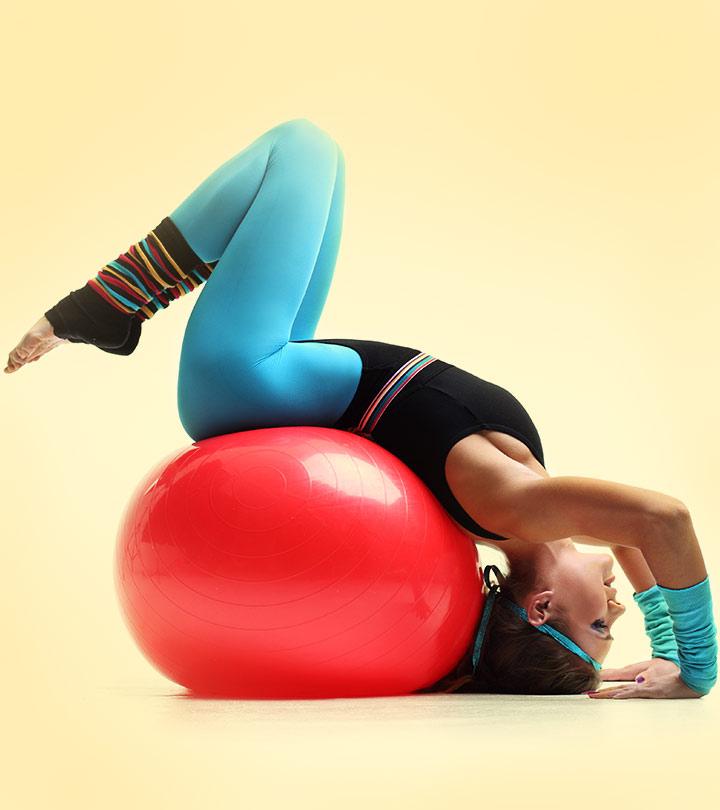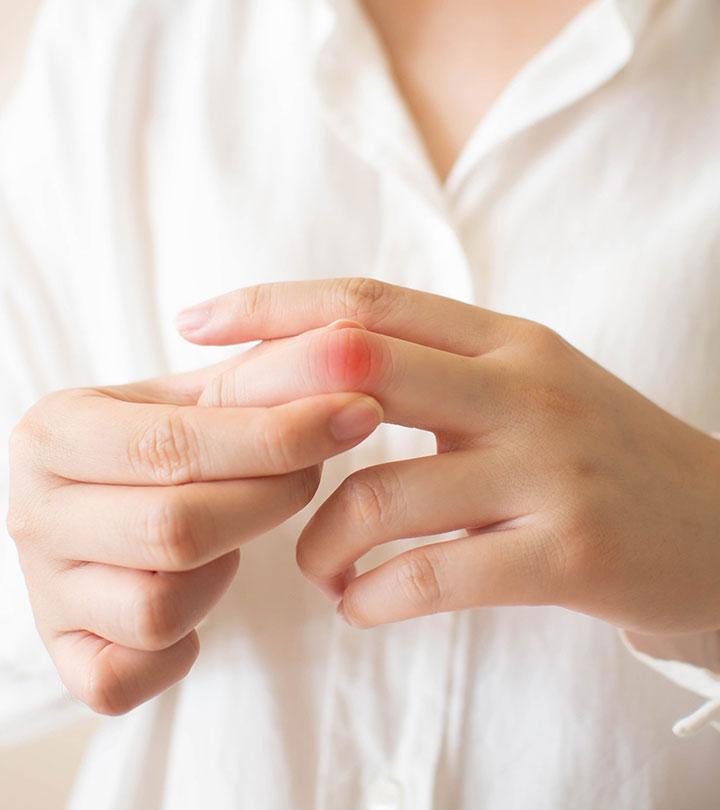15 Best Ways For Building Muscle For Women – Complete Guide
Tips and exercises to add to your workout program to reach your fitness goals!

Image: Shutterstock
When it comes to women building muscle, there’s a lot of skepticism related to bodybuilding. “Will I look muscular like a bodybuilder?” “Will I be able to fit in my clothes?” Well, the truth is, women should build lean muscle. Muscles contain mitochondria, the cell organelle that synthesizes energy and boosts metabolism (1). Building muscle also helps prevent muscle loss after 30 and keeps your body looking toned (2), (3). So, no, you will not look muscular bodybuilder. Read on to know the 15 best ways women can build muscle without looking too muscular. Swipe up!
 Workout Blueprint: Muscle Building Exercises
Workout Blueprint: Muscle Building Exercises- Frequency: 2-3 times per week
- Benefits: Improve muscle strength, metabolism, and agility.
- Equipment Needed: Dumbbells, resistance band, barbell, exercise mat.
- Space Required: Small area
- Assistance Required: Yes, for certain exercises
- Who Should Avoid: People with back pain, injured muscles, and heart issues.
In This Article
15 Ways Women Can Build Muscle
Workout
1. Strength Training
Strength training is the first step to take if you want to build muscle and strength (4). A typical strength training routine includes weightlifting and resistance training (dumbbells, barbells, kettlebells, and weight plates). It helps improve the strength of your muscles.
These exercises cause a lot of wear and tear in the muscles. When you rest or sleep, the muscles rebuild themselves – only, this time, they are broader and stronger.
Martha, a blogger, shared her experience of incorporating weight lifting into her schedule in her personal blog. She said, “In the first three months of my training, I looked bigger than what I was before exercising, but now, I’ve finally looked leaner as I’ve shed more fat in the process (i).”
Use your body weight, a TRX training band, or any resistance band to transform simple exercises into strength training. Here’s a sample strength training routine.
Sample Strength Training Routine
| DAY | TARGET | EXERCISES |
|---|---|---|
| Day 1 | Legs | Leg press, barbell squat, dumbbell lunges, barbell split squat, goblet plie squat, one-legged TRX squat, barbell hip thrust, and weighted walking lunges – 3 sets of 12 reps each |
| Day 3 | Chest And Triceps | Push-ups, planks, side planks, chest fly, dumbbell overhead press, incline dumbbell press, bent over row, resistance band skull crushers, resistance band tricep extension, and chest dips – 3 sets of 12 reps each |
| Day 5 | Traps And Shoulders | Dumbbell shrug, barbell row, lat press, lat row, lateral raises, plank, low cable face pull, machine shoulder press, overhead barbell press, one arm rear delt raises, and front raises – 4 sets of 7 reps each |
| Day 7 | Back And Biceps | Close grip pulldown, single-arm dumbbell row, standing T-bar row, bicep curl, hammer curl, barbell curl, plank up and down, and bicep push up – 3 sets of 12 reps each |
Remember, you must mix your workout to build a lean, toned, and strong body. Scroll down to know what you’ve got to do.
2. HIIT It!

Include HIIT (High-Intensity Interval Training) in your exercise routine to maintain a lean frame and get a chiseled body. HIIT includes fast and agile moves for 30 seconds with 10 seconds of rest in between the sets.
This short duration, high-intensity workout targets the fast-twitch muscle fibers, which are essential for building muscle (5), (6). It is a power workout and assists in toning and sculpting your muscles. This Endurance training or long-duration exercise like long runs or walks target slow-twitch fibers, which will not help build muscle.
Do the following exercises: high knees, alternate straight leg kicks, burpees, squat jumps, jumping lunges, rope jumping, battle rope, side jackknife, Russian twist, leg ins and outs, crunches, and sit-ups.
Make sure you take 60-90 seconds rest before switching to the next exercise. Take 10 seconds rest between the sets.
3. Push Yourself
Push yourself to do more reps, faster, and with precision. If you keep doing the same exercises with the usual number of sets and reps, you will not progress.
The more you practice, the more your muscles will adapt to the weights. Unless you increase the weight or add some level of difficulty, your muscles will remain the same size.
Tip: Work out 3 to 5 days a week and do strength training every alternate day to give your muscles time to recover.
According to a study on US adults aged 18 and over, it was found that the percentage of females who fulfilled the guidelines for both muscle-strengthening and aerobic activities declined with age from 2018 to 2020. It dipped from 28.7% to 22.7% in women aged 18–34; for women aged 35-49, it went down to 22.7%; for those aged 50–64, it dropped to 17.6%, and it was found to be only 10.8% for those aged 65 and more.
Apart from working out, you must also take care of your diet. Here are the diet strategies you can follow.
Diet
4. Consume Enough Protein
Lifting weights and doing HIIT will break down muscle protein. You need protein to rebuild the muscles. Sources like fish, chicken breast, soy chunks, beans, nuts, seeds, lentils, eggs, and mushrooms can help build and repair the muscles.
Sedentary women are required to consume 0.8 grams of protein per kilogram of body weight. But to build muscle mass, consume 1.7-1.8 grams of protein per kilogram of body weight. If you weigh 132 pounds (62 kg), you should consume 105-112 g of protein per day (7).
5. Have Pre- And Post-Workout Meals
Pre- and post-workout meals will help you ace the workout and recover fast from it, respectively (8).
Lifting weights requires energy, and by consuming a carb-rich, moderate protein pre-workout meal, you will provide your body with the required energy. Consume a protein-rich post-workout meal so that your muscles recover and rebuild fast.
 Trivia
Trivia6. Consume Healthy Fats In Limited Amounts
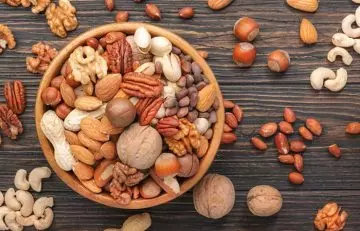
The healthy fats found in nuts, seeds, ghee, avocado, rice bran oil, and avocado oil are rich in vitamin E. Vitamin E is an antioxidant that helps flush out toxins (10). These food sources also contain omega-3-fatty acids, which help lower inflammation in the body (11). These healthy fats also help boost the recovery process when your body is resting.
7. Consume Good Carbs In Limited Amounts
Include high-fiber carbs, such as fruits, veggies, and whole grains, in your diet. They provide dietary fiber, vitamins, and minerals, which are essential for optimum health. These nutrients will ensure that you do not feel weak or fall sick easily.
 Quick Tip
Quick Tip8. Take Supplements

Supplements are great for people with highly busy schedules or who are very active. They provide the nutrition that you are missing out on from whole foods. Protein supplements are great for gaining lean muscle mass. However, you must talk to your physician and a registered dietitian before you take any supplement.
9. Limit Alcohol Consumption
Alcohol is metabolized as extra calories in the body, and too much of it in the system can lead to weight gain (12). You will also not have the energy and stamina to workout. If you want to build muscle, stick to a glass of wine, one to two days per week. Going overboard will end up slowing down your progress.
The next five points discuss one of the most ignored but important aspects of building muscle. Take a look.
Lifestyle
10. Rest
Resting helps in muscle recovery. If you don’t rest, you will injure yourself and may not get back to the gym. Rest between the exercises and sets and after going home for at least 20 minutes. Avoid lifting weights every day.
11. Wake Up Early
Waking up early will prompt you to go to bed early. That way, you can go to the gym in the morning or evening. You will also have time to fix a quick breakfast before you head out or consume a protein-rich dinner after you come back from the gym in the evening.
12. Get Enough Sleep
Sleep is important for allowing your muscles to recover from wear and tear (13). Get at least 7 hours of sound sleep. Your brain also needs the rest to function (14).
13. Meditate
Building a toned and strong body requires a certain degree of discipline. Meditation can help you stay focused and maintain a good lifestyle. It is tough in the beginning, but do not give up. Gradually, you will learn to train your brain and control your hunger pangs, lethargy, anxiety, and other emotions that may prevent you from getting the desired results soon.
14. Surround Yourself With Positive People
Positive people help inspire and motivate others. Surrounding yourself with positive people will make it less likely for you to fail in your personal and professional endeavors. Be it at home, work, or the gym, look for people with great energy and vibe so that you can learn from them and not give up on your wellness goals so easily.
15. Talk To Experts
If you are a beginner, it is best to have a personal trainer, who will suggest a proper exercise routine. Consult a registered dietitian for a customized diet plan. You can also talk to other people who share similar goals to build a community of support. Building social support is important so that you stay focused and do exercises correctly.
Wondering how long till you see some muscles on your body? Scroll down to the next section!
How Long Does It Take To Build Muscles For Women?
Building muscle for women varies depending on numerous factors, including age, genetics, workout intensity, type of training, metabolic rate, hormone levels, nutrition, and consistency. On average, women can expect to see progress in 2-3 months with consistent strength training and appropriate diet.
As women produce less testosterone than men, a hormone crucial for muscle growth, their muscle development may be slower compared to their male counterparts. Hence, adequate protein intake, caloric surplus, and progressive resistance training are recommended for muscle gain.
Remember, the journey of muscle building is gradual, and comparing your progress to someone else’s can be misleading due to individual variations. You may consult a fitness professional for personalized guidance.
Infographic: Women’s Guide To Building Muscle
Developing a lean, muscular body can assist your health in various ways. You need a well-planned workout regime, a balanced diet, and enough rest.
Check out the infographic below to understand how to gain muscles, how they benefit the body, what foods to consume to build muscles, and some recommendations to help you get the most out of your training routine. Illustration: StyleCraze Design Team
Unlike men, women building muscles might seem strange and lead to many raised eyebrows. However, thankfully women are better aware of their health and fitness now, willing to set some time apart to indulge in their favorite form of physical exercise as per their personal liking. It is now a common reality for many. Getting enough rest, staying hydrated, and consulting a physician and dietitian is important to see a visible difference soon.
Frequently Asked Questions
How many days a week should I workout to build muscle female?
Get at least two days of strength training/TRX/ bodyweight training to tone up your muscles. Do not go for strength training on consecutive days.
How much muscle can a woman gain in a month?
It depends on your diet, exercise plan, age, body type, current weight, stress, sleep, etc.
Do you gain weight when you gain muscle?
Muscles have more weight than fat. So, yes, you will gain weight.
Should I lose weight before building muscle?
This depends on your body composition. You can benefit from first losing fat and then building muscle if you have a very high body fat percentage (more than 35% for women and more than 25% for men). This way, you will be able to gain muscle mass while minimizing fat gain.
How do I know if weight gain is muscle or fat?
You can feel the difference between fat gain and muscle gain. Muscles will feel firmer or harder to the touch whereas fat gain will make your body parts feel softer. Fat gain also presents as inches gained, especially around the waist.
Does soreness mean muscle growth?
Muscle soreness after a workout session may indicate muscle damage, which usually translates to muscle growth. However, soreness after exercise may also indicate that you have injured yourself. Hence, consult your trainer to understand what your muscle soreness actually means.
Is it better to work out in the morning or at night?
It may be better to work out in the morning for weight loss and in the evening for muscle gain (15).
Key Takeaways
- Following a healthy diet with sufficient levels of protein is important for muscle growth.
- You should get about seven to nine hours of sleep as proper rest is crucial for muscle recovery and growth.
- Consistent strength training and HIIT workouts are key components of muscle-building for women.
- You can prevent any injuries while building your muscles by slowly and gradually increasing the weight you lift and the intensity of your exercises.
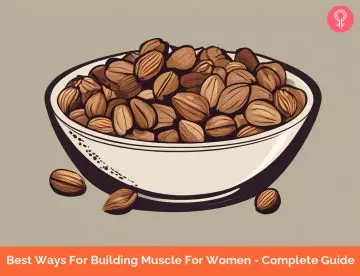
Image: Stable Diffusion/StyleCraze Design Team
References
Articles on StyleCraze are backed by verified information from peer-reviewed and academic research papers, reputed organizations, research institutions, and medical associations to ensure accuracy and relevance. Read our editorial policy to learn more.
- Plasticity in mitochondrial cristae density allows metabolic capacity modulation in human skeletal muscle, The Journal of Physiology, The Physiological Society
https://physoc.onlinelibrary.wiley.com/doi/10.1113/JP273040 - Research hypotheses on muscle wasting, aging, loss of function and disability, The Journal of Nutrition, Health & Aging, US National Library of Medicine, National Institutes of Health.
https://www.ncbi.nlm.nih.gov/pubmed/10993575 - Reversing sarcopenia: how weight training can build strength and vitality, Geriatrics, US National Library of Medicine, National Institutes of Health.
https://www.ncbi.nlm.nih.gov/pubmed/8621102 - The Importance of Muscular Strength: Training Considerations, Sports Medicine, US National Library of Medicine, National Institutes of Health.
https://www.ncbi.nlm.nih.gov/pubmed/29372481 - New insight of high-intensity interval training on physiological adaptation with brain functions, Journal of Exercise Nutrition & Biochemistry, US National Library of Medicine, National Institutes of Health.
https://www.ncbi.nlm.nih.gov/pmc/articles/PMC6199482/ - Increase in the proportion of fast-twitch muscle fibres by sprint training in males, Acta physiologica Scandinavica, US National Library of Medicine, National Institutes of Health.
https://www.ncbi.nlm.nih.gov/pubmed/2150579 - Dietary protein intake and human health, Food & Function, US National Library of Medicine, National Institutes of Health.
https://www.ncbi.nlm.nih.gov/pubmed/26797090 - Achieving Optimal Post-Exercise Muscle Protein Remodeling in Physically Active Adults through Whole Food Consumption, Nutrients, US National Library of Medicine, National Institutes of Health.
https://www.ncbi.nlm.nih.gov/pmc/articles/PMC5852800/ - Maximizing postexercise muscle glycogen synthesis: carbohydrate supplementation and the application of amino acid or protein hydrolysate mixtures
https://academic.oup.com/ajcn/article/72/1/106/4729442?login=false - Vitamin E, Antioxidant and Nothing More, Free Radical Biology & Medicine, US National Library of Medicine, National Institutes of Health.
https://www.ncbi.nlm.nih.gov/pmc/articles/PMC2040110/ - Omega-3 Fatty Acids and Inflammatory Processes, Nutrients, US National Library of Medicine, National Institutes of Health.
https://www.ncbi.nlm.nih.gov/pmc/articles/PMC3257651/ - Alcohol Consumption and Obesity: An Update, Current Obesity Reports, US National Library of Medicine, National Institutes of Health.
https://www.ncbi.nlm.nih.gov/pmc/articles/PMC4338356/ - Sleep deprivation reduces the recovery of muscle injury induced by high-intensity exercise in a mouse model, Life Sciences, US National Library of Medicine, National Institutes of Health.
https://www.ncbi.nlm.nih.gov/pubmed/31493480 - The sleep-deprived human brain, Nature Reviews Neuroscience, US National Library of Medicine, National Institutes of Health.
https://www.ncbi.nlm.nih.gov/pmc/articles/PMC6143346/ - Morning Exercise Reduces Abdominal Fat and Blood Pressure in Women; Evening Exercise Increases Muscular Performance in Women and Lowers Blood Pressure in Men, Frontiers in Physiology.
https://www.frontiersin.org/articles/10.3389/fphys.2022.893783/full#h6%20










